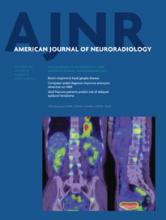Abstract
BACKGROUND AND PURPOSE: Brain hemorrhage is common in premature infants. The purpose of the study is to evaluate white matter development in extremely low-birth-weight infants with or without previous brain hemorrhage.
MATERIALS AND METHODS: Thirty-three extremely low-birth-weight infants were prospectively enrolled and included in this institutional review board–approved study. Another 10 healthy term infants were included as controls. The medical records of the extremely low-birth-weight infants were reviewed for sonography diagnosis of intraventricular hemorrhage. All infants had an MR imaging examination at term-equivalent age for detection of previous hemorrhage, and their white matter was scored and compared among different groups. DTI measured fractional anisotropy values were also compared voxelwise by tract-based spatial statistics.
RESULTS: Compared with controls, the white matter score was not significantly different in extremely low-birth-weight infants without blood deposition on MR imaging (P = .17), but was significantly worse in extremely low-birth-weight infants with blood deposition on MR imaging but no intraventricular hemorrhage diagnosis by sonography (P = .02), in extremely low-birth-weight infants with grade 1 or 2 intraventricular hemorrhage on sonography (P = .003), and in extremely low-birth-weight infants with grade 3 or 4 intraventricular hemorrhage on sonography (P = .0001). Extremely low-birth-weight infants without blood deposition on MR imaging did not show any white matter regions with significantly lower fractional anisotropy values than controls. Extremely low-birth-weight infants with blood deposition on MR imaging, but no intraventricular hemorrhage diagnosis, did show white matter regions with significantly lower fractional anisotropy values, and extremely low-birth-weight infants with intraventricular hemorrhage diagnosis had widespread white matter regions with lower fractional anisotropy values.
CONCLUSIONS: Previous brain hemorrhage is associated with abnormal white matter in extremely low-birth-weight infants at term-equivalent age, and sonography is not sensitive to minor hemorrhages that are sufficient to cause white matter injury.
ABBREVIATIONS:
- ELBW
- extremely low-birth-weight
- FA
- fractional anisotropy
- IVH
- intraventricular hemorrhage
- TBSS
- tract-based spatial statistics
- © 2014 by American Journal of Neuroradiology
Indicates open access to non-subscribers at www.ajnr.org












